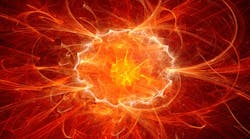Fear and Mitigation of an Electromagnetic Pulse
This article is part of the TechXchange: Delving into EMI, EMC and Noise.
Members can download this article in PDF format.
What you'll learn:
- What is an EMP and what organizations are monitoring such possible incidents?
- Details about EMP filters.
- Components and hardware needed for an effective detection system.
Most societies lead a relatively peaceful existence. However, many possible dangers may be lurking quietly to the detriment of our modern conveniences in life. Let’s look at an intentional or non-intentional risk from a high-altitude electromagnetic pulse (EMP).
An EMP can disrupt the normal operation of electronic devices due to excess energy being introduced into any system. The delivery method may be an electromagnetic burst of signals traveling on cables. Or it could be simply the event of freely propagating, high-level pulsing of electromagnetic waves in the atmosphere caused naturally via solar flares or lightning. The cause may also be intentional.
The U.S. Air Force has an Electromagnetic Defense Task Force (EDTF) that provides recommendations as to how the risk of an EMP can be prevented and/or mitigated. The U.S. Department of Homeland Security (DHS) is tasked with preparing against ever-evolving threats against the country.
EMP Filters
Every type of filter will dissipate heat and power, leading to a rise in ambient temperature as well as contributing to the filter’s overall operating temperature. HEMP/EMP filters must be placed in every critical piece of equipment’s AC input-line circuitry and near to the point of power entry.
As a precaution, EMP filters must be able to withstand an abruptly failing system and allow that system to fully function. It’s also essential that the system be able to run as long as an hour, at 125% of the circuit breaker’s filter current rating, while sustaining no damage.
A number of factors are involved in enabling a filter to maintain a fault-tolerant operation:
- Operating temperature, for every component within the filter, can’t surpass the maximum rated temperature.
- Filter ambient temperatures of 55 to 80°C should be tolerable.
- Inductor windings, in hardened filters, must be capable of tolerating a filter’s full-rated current.
- Inductor core losses can contribute to overheating within the filter; temperature monitoring is necessary.
- Capacitors may be exposed to the full-rated voltage of the filter (and 0.577 rated voltage in three-phase filters).
- Capacitor voltage rating must be a minimum of 10% higher than the maximum line voltage for X-capacitors and the line-to-ground voltage for Y-capacitors. Fault-tolerant filters should have 275- to 305-V-AC-rated X-capacitors to extend the X-capacitor’s life. Y-capacitors are typically rated for 275 V AC in single-phase applications; however, 305-V-AC-rated Y-capacitors are recommended (see Reference 1 for more details regarding Capacitor Choice).
- Current draw vs. rated current: The current rating of a filter is the maximum steady-state RMS current that will be able to continuously flow through that filter without causing any kind of damage.
- Global voltage considerations: Design engineers should choose a filter that has the highest available voltage rating (i.e., commonly available) to ensure that the filter can exist in the global arena.
- Maximum rated voltage and current: Rugged HEMP/EMP filters must be designed for maximum rated voltage and current that cannot be exceeded. Design engineers need to ensure that a filter’s rating is sufficient for both the highest-rated input voltages and maximum current draw (this will usually be at the lowest power supply voltage).
- Operating frequency: HEMP/EMP filters are typically employed using 50/60-Hz AC current. However, 400 Hz presents a challenge because it may raise a filter’s leakage current and core losses, causing the capacitors and inductors to rise in temperature, possibly leading to system failure. It’s imperative that the 400-Hz filter be designed to operate safely.
Detection Systems that Register Electromagnetic Disturbances
The process of registering electromagnetic wave phenomena, which have both a large dynamic range along with broad frequency coverage, is accomplished with specialized, but typically quite costly and bulky, laboratory equipment.
With a practical sensing solution, designers should be able to accommodate tight budget constraints of site operators.3 This is why designers must endeavor to maintain the total hardware costs to a minimum that will be well within the targeted performance profile.
Component Hardware for a Detection System
Analog signal processing
Antenna: A compact loop antenna design with the ground plane seated flush with the aluminum walls of the detector casing. Basic requirements include:
- Capability for a broadband signal acquisition over the relevant frequency range (ranging from a few hundred MHz to 10 GHz)
- Using a flat frequency response over a high gain.
- Having no voltage breakthrough, even at field strengths in the kilovolt ranges
- A compact antenna design having mobility as a design goal.
- Having sensitivity to all wave polarizations such as vertical, horizontal, or circular regardless of either left or right handedness.
Attenuation: After the antenna acquires the signal, it will need to be attenuated to avoid damage when entering the low-level RF electronics. Three components are included in each of the eight initial signal paths—two attenuators that are sandwiching a limiter. Their properties will determine the measuring range of the overall system.
Demodulation: This follows the attenuation of the signal. Subsequently, the signal processing moves into a separate module that’s shielded—the inner printed circuit board (PCB). Since there’s the possibility of any disruption attempts, which may span orders of magnitudes in field strength, a logarithmic detector is now employed to demodulate the signals that have a high dynamic range. Next, output reactivity will enable sampling of signal envelopes on a time scale of a few ns for even more digital data processing.
Frequency detection: Two loop antennas will be mounted atop a detection device to acquire signals of all polarizations to determine the carrier frequency of any narrowband signals. Then their superimposed signals are input into a limiter and further attenuation is performed. Next, a limiting amplifier will normalize the signal amplitude to the frequency-detection circuitry. After that, a frequency divider will compress the system input frequency range to fit the specification of two 8-bit frequency counters. The counters are alternately gated with a bit of overlap that will prevent acquisition downtime.
Digital data processing
- FPGA for raw data processing: To be able to sample the raw data stream from the four signal channels plus the frequency information, an FPGA will have the outputs of four analog-to-digital converters (ADCs) as well as those from the frequency counters. Subsequently, a custom core will arrange for the raw data to be preprocessed and then sent into a FIFO downlink.
- A single-board computer for additional processing: All of the further processing will take place in a Raspberry Pi compute module that’s also used to load a core into the FPGA at system startup. Then it will host the backend process handling system control and perform corrections to the amplitude values.
General casing and power supply
All of the hardware components in the sections above will reside within the RF-proof outer cubical aluminum housing of the detector, which is 19 cm in edge length and mounted on a tripod base. The cube base has a mark for locating the internal magnetic power switch, a few status LEDs, and the optical-fiber connections for network access.
Another connector for an external custom power supply may be used to charge the internal LiFePO4 battery pack, which occupies almost half of the space within the cubical outer housing.
Summary
EMPs have been known to be a serious national security threat since the 1960s. On March 26, 2019, President Donald Trump issued an Executive Order to enable the United States to prevent and even respond to any EMP attack or “geomagnetic disturbance” (GMD).
Read more articles in the TechXchange: Delving into EMI, EMC and Noise.
References
1. “Fault Tolerant EMP Filter Design and Construction,” tss manufacturing, USA.
2. “The Emerging Threat of Tactical Electromagnetic Interference & Its Spread into Non-Defense Sectors,” Paul Currie, January 29, 2020.
3. “A forensic detection system for intentional electromagnetic interference (IEMI) attempts,” Thorsten Pusch, Christian Adami, Sven Ruge, Michael Suhrke, IEEE 2023 International Symposium on Electromagnetic Compatibility—EMC Europe, IEEE 2023.

